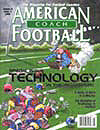AMERICAN FOOTBALL MONTHLY THE #1 RESOURCE FOR FOOTBALL COACHES
Article CategoriesAFM Magazine
|
On TargetTransforming Your Defense into a \'Smart-Weapon, Guided-Missile\' Attacking Defenseby: Dr. Joe Hollingsworth © More from this issue During the 1990s many defenses were transformed from "read and react" defenses into attacking defenses. An effective attacking defense is not just a loose cannon, it's a guided missile. To be effective you have to know when and where to attack. Sophisticated scouting software of an opponent's offense through statistical analysis gives the defensive coaching staff the tools they need to create a "smart-weapon, guided-missile" attacking defense. Creating Defensive Call Sheets to Base Your Attack on Situations "If you've done your homework, during the game you should be making your defensive calls from a call sheet. That means you have to know (based upon scouting) what your opponent is likely to do according to down and distance, hash mark or different field zones (e.g., in your red zone). ....The full article can only be seen by subscribers.
|
|
|||||||
| HOME |
MAGAZINE |
SUBSCRIBE | ONLINE COLUMNISTS | COACHING VIDEOS |
Copyright 2025, AmericanFootballMonthly.com
All Rights Reserved





